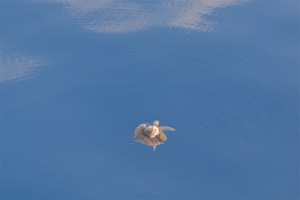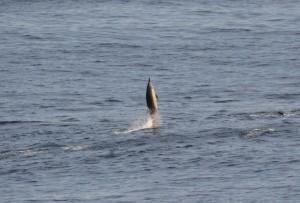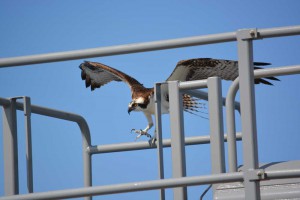It was a spellbinding first week at sea. The weather’s been warm and the ocean has been calm as we continue our journey south. The first few days coincided with the new moon, which created ideal conditions for stargazing. It has been interesting to follow our progress on Earth by observing the night sky. As we advance toward the equator, Polaris descends, dropping closer to the horizon every night. At the same time, more southerly constellations have made themselves visible, illustrating new sagas in the sky. What a wonderful way to gain fresh perspective on our place in the solar system!

A green sea turtle swims through a calm ocean. (Photo by Kali Armstrong, Woods Hole Oceanographic Institution)
There is plenty to observe during the day, as well. The sun’s rising and setting over the ocean has been breathtaking. The sea surface reflects all the dreamy colors of the sky like a liquid mosaic. Wildlife is abundant in these warm, tropical waters and I have been very fortunate to identify a new species every day. Pacific spotted dolphins have been seen most often and make the most wonderful company. It is such a joy to watch them leaping alongside in the waves made by the ship. Just a day or so ago, we watched an entire pod excitedly feast on a bait ball of smaller fish. In addition to dolphins, tuna and myriad birds participated in the smorgasbord. Ecology at its finest!
Sea turtles–green and loggerhead–have been a delight to observe, lazily floating along the sea surface. Every now and then, you’ll catch a booby bird hitching a ride on a turtles’ shell. (One has to wonder if they’ve somehow been given permission.) There are four species of booby in the tropical Pacific. Possibly the most popular is the blue-footed booby, known for nesting on the Galapagos Islands. However, red-footed, brown and masked boobys all flourish here, as well. Watching them in hot pursuit of scattering flying fish is quite the sight as their razor-sharp wings etch through the air with precision and ease.
It is intoxicating to imagine what wonders the Atlantic Ocean will hold!




